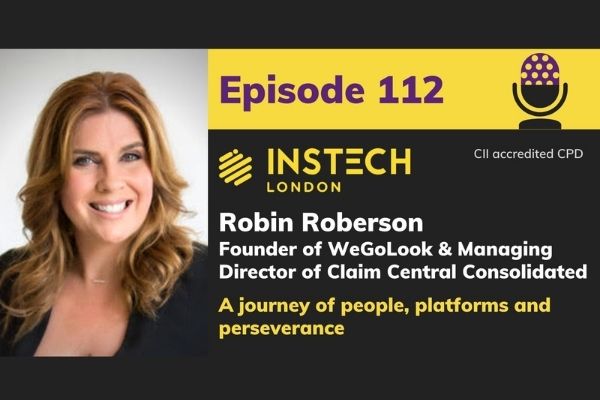Turning a start-up into a successful company requires the ability to clearly identify customer problems and spotting market opportunities for growth.
A conversation with a friend about eBay led Robin Roberson to found WeGoLook, which grew from mitigating risks around online purchases to helping assess property damage from natural catastrophes.
Robin joins Matthew on Podcast 112 to share her inspiring story on growing a new business, leveraging technology and her new role at Claim Central Consolidated.
Listen now to learn about:
- Switching careers and starting a company
- Why start-ups need to shift and pivot
- Finding the balance between people and tech
- Cybersecurity and data protection
- The challenges for female founders
If you like what you’re hearing, please leave us a review on whichever platform you use, or contact Matthew Grant on LinkedIn.
Sign up to our newsletter for a fresh view on the world every Wednesday morning.
A journey of people, platforms and perseverance – Podcast 112 highlights
Matthew: Robin, I’m really interested to hear how you went from a broadcasting career to starting WeGoLook. What gave you the motivation to move from one area into another?
Robin: I worked for The Washington Post after college and learned a lot about different customers, the back end, the front end and what made them tick. I loved what I was doing, but after a change in my personal life I felt I needed to start my own company and have a flexible schedule.
I started several companies and learned a lot about the automotive business from working with car dealership clients. Then a friend of mine was looking at a high-end projector on eBay but he wasn’t sure if the seller was real. I thought there had to be a service for that, but I couldn’t find a company doing it. I thought wow, this could be a great solution to a problem out there.
I started WeGoLook to mitigate risk when buying something sight unseen. Then figured out how to create a large network of independent contractors that could be dispatched on demand to collect field data in the form of photos, video, etc. That’s how it all started.
Matthew: How did the company move from eBay purchases into claims?
Robin: We’d focused on automotive and done some work for banks, but individual items like pinball machines, collectables, heavy equipment, were our sweet spots for individuals back then.
We had to shift and pivot. An important component of growing a start-up is listening to what customers need and spotting market opportunities. Superstorm Sandy made that happen for us. There was a large bank that needed a portfolio of properties looked at. We were able to go in with a FEMA certified looker, capture the information and submit it back.
This was in 2012 and I still didn’t realise that insurance was where we needed to be. The kicker was a client introduction to one of the nation’s largest companies through an RFP process. That contract opened my eyes and I started learning everything I could about insurance.
Matthew: You had to find clients for WeGoLook, but you also needed to build a network of lookers. How did you find the right people?
Robin: We looked for mobile notaries, process servers, people already independently going out to meet people and follow instructions. We also worked with military personnel during that initial push. We realised as we grew and our training modules improved that we could bring on retired people that had been professionals back in the day.
What’s fascinating now is that companies don’t have to build and maintain a network like that anymore. They can just connect to them. They have access to services like Uber, Lyft, Postmates and StreetDelivery, all via technology. It’s fascinating to see what we worked so hard to achieve can now be multiplied by leveraging technology.
Matthew: What’s your view on the balance between technology and people? Are we still some way from technology replacing people for some decision-making choices in underwriting or claims?
Robin: Today’s policyholders are much more apt to try to use the technology that’s provided to them by the carrier or a third party because they don’t want anyone coming to their home.
A combination of technology with people will always still be needed, but I do believe that technology will take over a lot of manual processes. People can then focus on more complex decisions or customer relationships. It’s hard to have a customer relationship with a phone, so that’s where people will be needed.
Matthew: You sold WeGoLook and are now running Claim Central Consolidated for North America. What does that software offer?
Robin: We’ve built an open marketplace to connect service providers and insurtechs. People will be familiar with Guidewire and this is very similar, but we’re adding the services component to it. It’s very affordable to clients of all sizes and we’re focused on those that are underserved as well.
We just purchased Livegenic, the video collaboration tool, and we can pair them with Hover for example and provide a service to the carrier. There are lots of ways to mix and match components and we have pre-bundled solutions as well.
Matthew: What about integrations? Is it relatively straightforward to connect people to the platform? Or are there still challenges?
Robin: It depends on the customer and where they’re at on their digital roadmap. I can remember going to conferences four years ago and talking about API connectivity in the cloud and people would look at me with a blank stare.
API connectivity is now expected for companies and that’s the way we want to work with people, but there are still companies out there that require a custom integration.
Matthew: What’s the business model for Claim Central Consolidated? How does it make money out of the platform?
Robin: We aren’t charging anyone to be a customer. We’re monetising by collecting a fee from the providers. It’s like a referral fee for bringing them extra business.
Some providers require a minimum volume commitment from an individual carrier or customer. We don’t do that, so companies can save money with us because they can pay per use of a product through the platform.
Matthew: Are the providers validated? So, if someone uses one of your partners, do they know there’s been a level of due diligence?
Robin: We’re working primarily with vendors and service providers that we’re familiar with and that customers are asking for. We’re creating a formal process for companies that we don’t know or that are new to the market. There are a lot of roads still to go to make this as robust as we want, but we’ve made an incredible start and it’s very exciting.
Matthew: Where are your customers coming from?
Robin: We have a fantastic pipeline. We’re channel partners with Aon and we’re looking at some other large distribution channels to help with exposure into the marketplace. We’ve also been able to leverage the contacts that we know.
Leveraging insurtechs and multiple providers into one legacy system has been very difficult for some of the larger carriers, and it’s a problem that we’re tackling.
Matthew: What do you see as being some of the most interesting areas evolving in technology and analytics for insurance?
Robin: Cybersecurity is very important. I’ve learned a lot about data tokenisation and there’s a need for all companies and carriers to protect their data, even with their third-party vendors. Vendor platforms typically have access to carrier customer information, but by using TokenEx’s data tokenisation layer, a vendor never stores that customer information. If a company gets hacked, the bad guys don’t have any information. It’s all just numbers and characters.
That’s going to become more and more important because as we share more information across all these APIs, we have to protect it. We can do that by incorporating protocols into a cybersecurity policy that can easily be enforced.
Matthew: The insurance industry comes under criticism for a lack of female leaders. There’s a lot more recognition of that need, but are things improving in your experience?
Robin: It’s on the investment side as well. The major investment firms and private investors are typically male, so there have to be women receiving funding as well.
I have seen more of a focus on female founders over the last few years. There has been research on how female founders typically have a higher success rate than their male counterparts – such as this one from Forbes. The Quesnay Female Founders in Tech programme has been great, there have been a lot more women involved in the speaking circuit and I’ve seen event coordinators working hard to include women.
There are women out there making a difference in leadership roles. Martha Frye is an SVP at Nationwide, Lori Pon at The Auto Club Group, Cat Reese at Tower Hill Insurance. As we continue to see more and more women and hear their stories, that will have a ripple effect. We still have a long way to go, but we’ve made a lot of progress.
Continuing Professional Development – Learning Objectives
InsTech London is accredited by The Chartered Insurance Institute (CII). By listening to an InsTech London podcast, or reading the accompanying transcript, you can claim up to 0.5 CPD hours towards the CII member CPD scheme.
Complete the InsTech London Podcast Feedback Survey to claim your CPD time.






